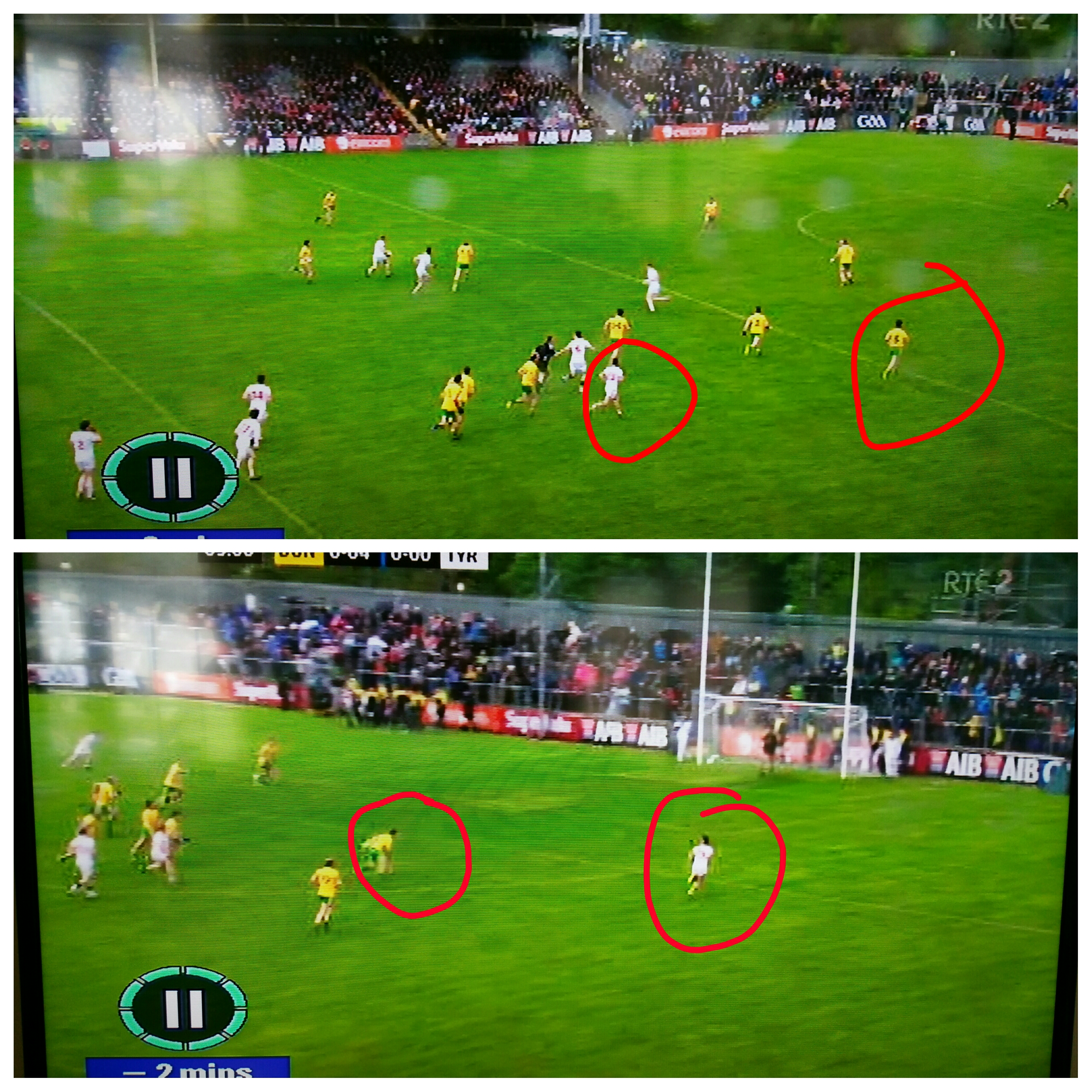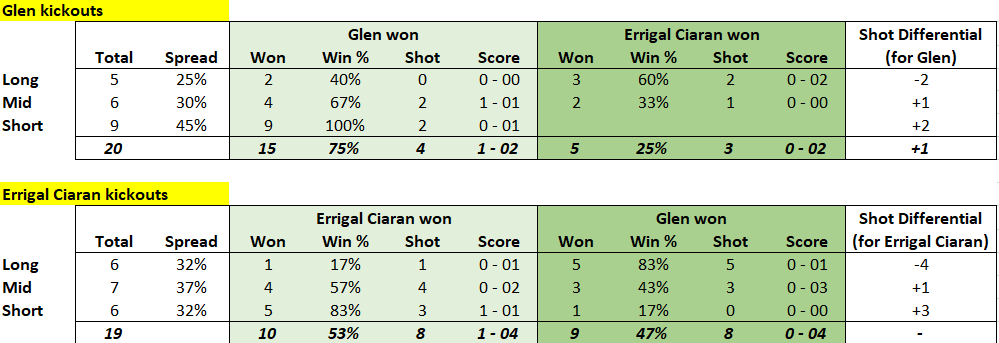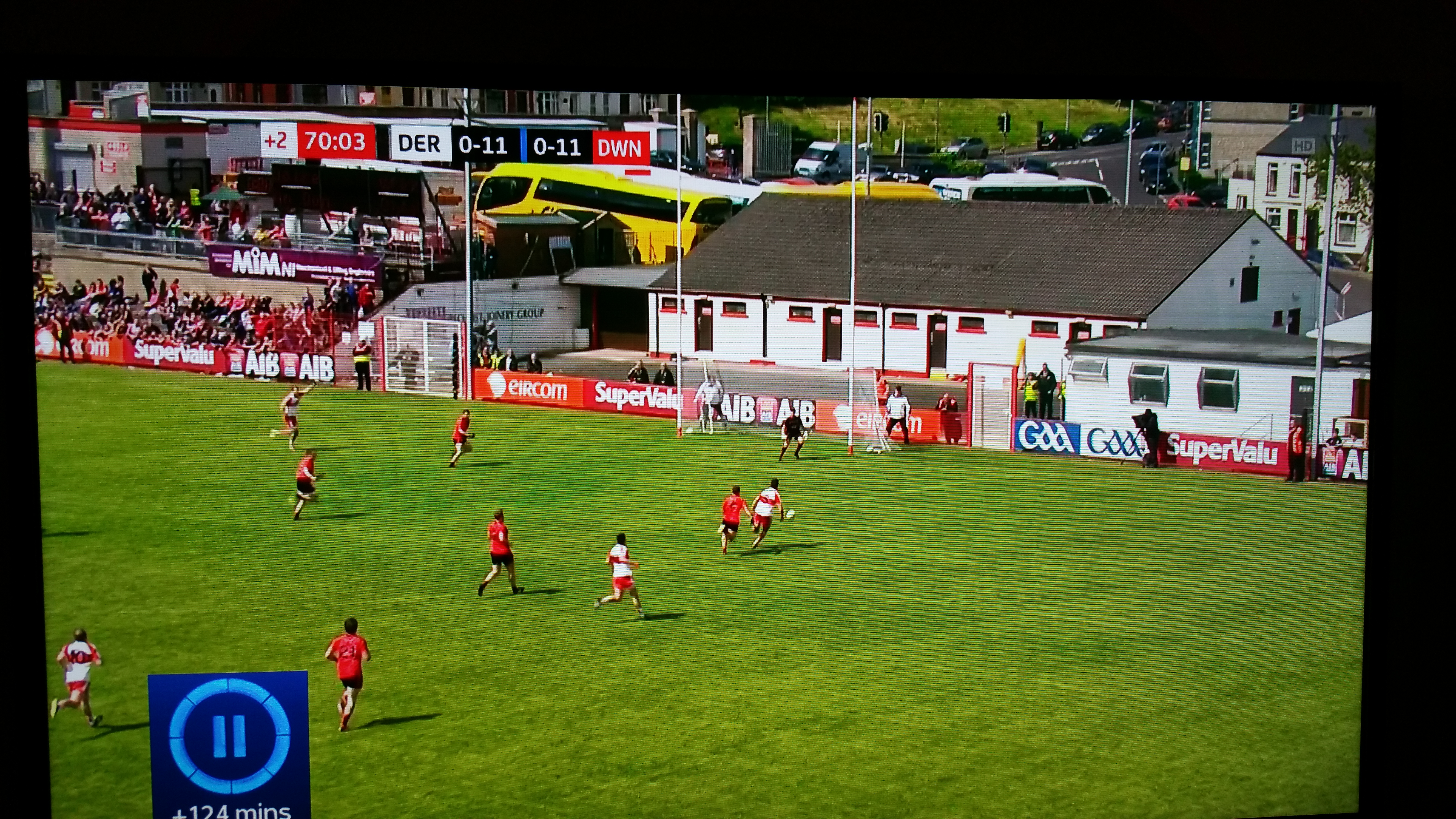For those new to the blog, or who haven’t been here for a while, please find a refresher on the definitions and how the numbers are compiled here
Overall
| Team |
Possessions |
Attacks |
Attack % |
Shots |
Shot % |
Scores |
Success % |
Weighting |
| Donegal |
41 |
31 |
76% |
25 |
81% |
14 |
56% |
+2.102 |
| Tyrone |
48 |
43 |
90% |
27 |
63% |
11 |
41% |
-2.477 |
| Avg |
|
37.0 |
|
28.7 |
77.7% |
14.7 |
51.2% |
|
Tyrone had their chances. They had two more shots than Donegal, after engineering 12 more attacks, but ultimately it was Donegal’s superior shooting and efficiency that saw them through. Sound familiar? Below are the returns from the 2013 game. Eerily similar. The faces may change (Joe McMahon, Stephen O’Neill, Rory Kavanagh, Leo McLoone, Jim McGuinness) put the pattern remains.
Overall
| Team |
Possessions |
Attacks |
Attack % |
Shots |
Shot % |
Scores |
Success % |
Weighting |
| Donegal |
43 |
29 |
67% |
18 |
62% |
12 |
67% |
+2.761 |
| Tyrone |
49 |
37 |
76% |
29 |
78% |
10 |
41% |
-3.015 |
Both teams went about accumulating their shots in very different manners. Donegal dropped back not engaging Tyrone until they crossed their 45. This enabled Tyrone to convert a very high proportion (90%) of their possessions to an attack. Tyrone on the other hand were more inclined to press thus stopping Donegal getting vast sways of their possession into an attacking position. As we have seen however, both in the corresponding 2013 fixture and throughout this team’s existence, Donegal are deadly efficient when they are at their best.
Shots from Play
| Team |
Shots |
Scores |
Success % |
Weighting |
| Donegal |
21 |
11 |
52% |
+1.183 |
| Tyrone |
21 |
8 |
38% |
-1.169 |
| Avgs |
21.4 |
9.7 |
45.3% |
|
One might think that a large part of Tyrone’s inefficiencies here came from their goal attempts. They did have six shots at goal with only McCurry’s attempt registering however when they went for points they were only average – a combined stat line of 7 from 15 (47%) with a weighting of -0.141. Looking at the shot charts below there weren’t too many outlandish speculative attempts – it was just average shooting from average positions.
Donegal on the other hand were 59% (10 from 17) with a combined weighting of +1.535 when going for a point.
One area Donegal will review is the Tyrone goal. McCurry found himself in acres of space after drifting in behind the defence following a quick free in the middle of the park. Excuse the poor drawing (!) but you can see in the below snapshots that Donegal had plenty of men back but Ryan McHugh got sucked into the ball allowing the space to appear.

Shots from deadballs
| Player |
Shots |
Scores |
Success % |
Weighting |
| M Murphy (Donegal) |
4 |
3 |
75% |
+0.919 |
| S Cavanagh (Tyrone) |
3 |
3 |
100% |
+0.624 |
| D McCurry (Tyrone) |
3 |
0 |
0% |
-1.932 |
| team avgs |
7.2 |
4.9 |
68.7% |
|
All the regulation frees were converted.
Séan Cavanagh’s placed ball day was good getting the two in front of goal you would expect any intercounty layer to convert whilst also swinging over the only difficult one he had from the left.
In 2013 Niall Morgan had a poor day converting one from six however he was in the main attempting very difficult long range “boomers” that are missed more often than they are converted. Although McCurry only missed three frees, compared to Morgan’s five, his day was perhaps even worse given that two of his frees were relatively easy. Granted the one in the second half was against the wind but he missed on the *near* side.
It was to Tyrone’s credit that Donegal’s first attempt at a score from a free was not until the 51st minute. Murphy missed that one but then took over converting two long range efforts including a 45 near to the right sideline – the *wrong* side for a right footer.
Turnovers
| Team “coughing up” possession |
Volume |
Shots from Turnovers |
% |
| Donegal |
20 |
10 |
50% |
| Tyrone |
24 |
13 |
54% |
One area that Donegal will no doubt review is their turnovers. Not necessarily the volume but where they gave them away. Of the 20 turnovers given up four were within their own 65. Tyrone only managed one point from this but in another tight outing – against Armagh or possibly Monaghan – that could yield precious scores.
Perhaps even more surprising is that Karl Lacey gave up three of those four. I’m guessing he won’t like this week’s video review session!
Kickouts
| Donegal’s kickouts |
Won |
% |
Turned into an attack |
% |
Shot |
% |
| Donegal |
11 |
52% |
6 |
55% |
5 |
45% |
| Tyrone |
10 |
48% |
9 |
90% |
6 |
83% |
|
| Tyrone’s kickouts |
Won |
% |
Turned into an attack |
% |
Shot |
% |
| Donegal |
5 |
25% |
4 |
80% |
4 |
80% |
| Tyrone |
15 |
75% |
14 |
93% |
9 |
60% |
At a macro level Tyrone won the kickout battle. Donegal’s kickout, from a volume & shot perspective, was a washout whilst Tyrone kept the ball by going short on their own. Strike out the short kickouts – which are not really contestable – and Tyrone win the kickout battle 15 – 12. Not as comprehensive but still a position of strength.
Donegal went short on four of their kickouts; of the 17 that crossed the 45 Tyrone got their hands on ten. Once they got ahead Donegal did not go short once.
On the opposite end of the scale Tyrone went short with 50% (10 out of 20) of their kickouts. Of those that passed the 45 the teams were split 50:50 (5 apiece) in terms of who came up with the ball. Against the wind in the second half they went short with 78% (7 out of 9) of their kickouts – this was obviously aided by Donegal who were dropping back to protect the lead.
Shot Charts
Donegal’s shooting

Note; I’m not sure if it was an issue with my feed or RTE but there was a blue screen for one of McElhinney’s attempts at a point. We know it went wide but we do not know where it was taken from so it is not represented in the above chart. For weighting purposes it is assumed the shot was taken from Sector 4 as the camera panned to McElhinney trotting back to midfield from the right hand side post shot.
Tyrone’s shooting

x = missed, disc = score, yellow = deadball, black = 1st half from play, white = 2nd half from play,
Players with >= 3 shots from play
Nothing earth shattering though it is noteworthy that McFadden got two of his three attempts. As noted (here) he had a very poor 2014. It was nice to see him back converting one lovely one with the outside of the left just before half time as well as jinking through for a shot at goal that was ultimately called back for a foul he incurred on his way through.
|
Shots |
Scores |
Success % |
Weighting |
| M McElhinney (Donegal) |
5 |
3 |
60% |
+0.658 |
| C McAliskey (Tyrone) |
4 |
3 |
75% |
+1.040 |
| C Toye (Donegal) |
4 |
2 |
50% |
-0.004 |
| P McBrearty (Donegal) |
3 |
2 |
67% |
+0.894 |
| C McFadden (Donegal) |
3 |
2 |
67% |
+0.442 |
| S Cavanagh (Tyrone) |
3 |
2 |
33% |
-0.218 |


























